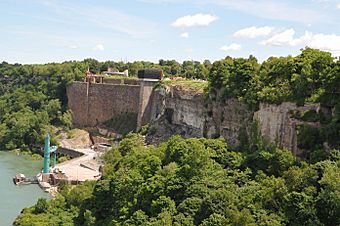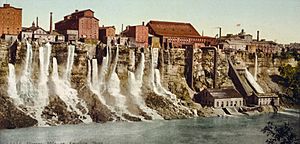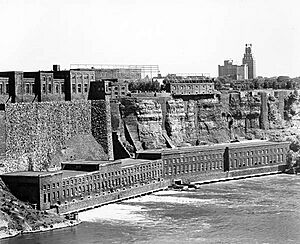Schoellkopf Power Station facts for kids
Quick facts for kids |
|
|
Schoellkopf Power Station No. 3 Site
|
|

Schoellkopf Power Station No. 3 Site
|
|
| Location | East Bank of Niagara River, 1,600 feet downriver from Rainbow Bridge, Niagara Falls, New York |
|---|---|
| NRHP reference No. | 13000029 |
| Added to NRHP | February 20, 2013 |
The Schoellkopf Power Station was a very important power plant built near the Niagara Falls. It was located on land owned by Jacob F. Schoellkopf, high above the Niagara Gorge. This spot was about 1,600 feet (488 meters) downstream from the Rainbow Bridge.
Jacob F. Schoellkopf understood that people needed more and more electricity. He saw how the powerful Niagara Falls could be used to make this energy. So, in 1877, he bought the land to build a special canal. This canal would carry water from the river to power his machines.
After Jacob F. Schoellkopf passed away in 1903, his sons continued the family's power business. Later, in 1918, Schoellkopf's company joined with another big power company. At one point, many people thought this power plant was the best hydroelectric plant in the world. A hydroelectric plant uses the force of moving water to create electricity.
Today, parts of the old Schoellkopf site are used by the Maid of the Mist boat tour company. They use it for boat repairs and to store boats when it's not tourist season. The remaining parts of the power station are now a cool place for tourists to visit. It's part of the Niagara Falls State Park and connects to its hiking trails in the Niagara Gorge.
Contents
How the Schoellkopf Power Station Worked
The Schoellkopf Power Station was built in different stages over many years. Each new part helped make more power.
Station No. 1: Early Power from Water
Work on a "Hydraulic Canal" began way back in 1853. This canal was designed to bring water from the Niagara River, above the falls, down to the river bluff below. The very first plant, built in 1874, didn't make electricity. Instead, it used water turbines to power belts and drive shafts. These shafts then ran machines in nearby mills.
In 1882, Schoellkopf teamed up with Charles F. Brush. Brush brought a special machine called a dynamo and 16 carbon arc lights to Niagara Falls. These lights were used to light up the streets of Niagara Falls, New York. The first dynamo at the plant was very powerful, making 1,800 horsepower. It ran until 1904, when a newer, better station (Station No. 2) took its place. This first station was also known by other names, like the Quigley Pulp - Lower Mill.
Station No. 2: A Bigger Power Plant
In 1898, a second, much larger hydroelectric plant was built. It was located right in front of Schoellkopf's original 1874 plant, at the bottom of the bluff. This new station could produce 34,000 horsepower! It continued to operate until it was shut down in 1921.
Station No. 3: Even More Power!
Station No. 3 was built in several parts to make even more electricity.
- Station No. 3a was finished by 1914. It had 13 turbines, each making 10,000 horsepower.
- Station No. 3b started being built in 1918. It had three generators that together produced 112,500 horsepower.
- Station No. 3c was completed by 1924. It was very powerful, with a capacity of 210,000 horsepower.
Because the old canal was already being used to its fullest, a new tunnel was built. This new tunnel helped supply enough water to the powerful new Station No. 3.
The Collapse of the Power Station
On June 7, 1956, a big problem happened at the Schoellkopf Power Station. Water started leaking into the back of the plant from the wall that was built against the bluff. This caused the wall to crack.
At 5 p.m. that day, Station No. 3c and then Station No. 3b were flooded. They collapsed into the Niagara River! This accident destroyed two-thirds of the plant. Six generators, which produced over 300,000 horsepower, were lost. The power grid lost 400,000 kilowatts of electricity. The damage was estimated to be around $100 million.
The parts of the plant that remained either fell into the gorge or were taken down soon after. Station 3A was damaged but kept working at a lower level until 1961. This big collapse led to a new law being passed in 1957, called the 1957 Niagara Redevelopment Act.
Station No. 3a was taken down in 1962. This was part of Robert Moses's plan to make the American side of the Falls look nicer. The electricity that was lost from the 1956 collapse was replaced by the Robert Moses Niagara Power Plant. This new plant started working in 1961.
The only part of the Schoellkopf site that still stands today is a stone wall. This wall is known as Power Station No. 3. It was built between 1908 and 1910 as part of the efforts to beautify the area. This wall was added to the National Register of Historic Places in February 2013. Sometimes, depending on how much water is flowing in the river, you can still see twisted metal beams and even parts of a generator turbine that fell into the river!




